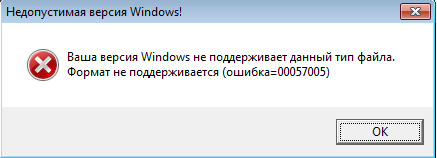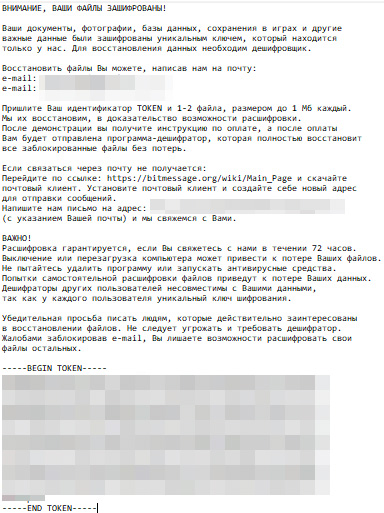Ransom.Win32.VEGA.THBAAAI
Trojan.Ransom.Buhtrap.A (BitDefender)
Windows


Threat Type: Ransomware
Destructiveness: No
Encrypted: Yes
In the wild: Yes
OVERVIEW
Dropped by other malware, Downloaded from the Internet
This Ransomware arrives on a system as a file dropped by other malware or as a file downloaded unknowingly by users when visiting malicious sites.
It drops files as ransom note.
TECHNICAL DETAILS
385,656 bytes
EXE
No
11 Feb 2019
Displays message/message boxes, Steals information
Arrival Details
This Ransomware arrives on a system as a file dropped by other malware or as a file downloaded unknowingly by users when visiting malicious sites.
Installation
This Ransomware adds the following processes:
- cscript //e:vbscript //nologo %User Temp%\temp.txt
- chcp 1250 && net view -> used to gather list of computers and devices on the network
(Note: %User Temp% is the current user's Temp folder, which is usually C:\Documents and Settings\{user name}\Local Settings\Temp on Windows 2000(32-bit), XP, and Server 2003(32-bit), or C:\Users\{user name}\AppData\Local\Temp on Windows Vista, 7, 8, 8.1, 2008(64-bit), 2012(64-bit) and 10(64-bit).)
Other System Modifications
This Ransomware deletes the following files:
- %User Profile%\documents\Default.rdp
(Note: %User Profile% is the current user's profile folder, which is usually C:\Documents and Settings\{user name} on Windows 2000(32-bit), XP, and Server 2003(32-bit), or C:\Users\{user name} on Windows Vista, 7, 8, 8.1, 2008(64-bit), 2012(64-bit) and 10(64-bit).)
It adds the following registry keys:
HKEY_CURRENT_USER\Software\Microsoft\
Terminal Server Client\Servers
It deletes the following registry keys:
HKEY_CURRENT_USER\Software\Microsoft\
Terminal Server Client\Default
HKEY_CURRENT_USER\Software\Microsoft\
Terminal Server Client\Servers
Process Termination
This Ransomware terminates the following processes if found running in the affected system's memory:
- agntsvc.exe
- anvir.exe
- anvir64.exe
- ccleaner.exe
- ccleaner64.exe
- dbeng50.exe
- dbsnmp.exe
- encsvc.exe
- far.exe
- firefoxconfig.exe
- infopath.exe
- isqlplussvc.exe
- isqlplussvc.exe
- msaccess.exe
- msftesql.exe
- mspub.exe
- mydesktopqos.exe
- mydesktopservice.exe
- mysqld.exe
- mysqld-nt.exe
- mysqld-opt.exe
- ncsvc.exe
- ocautoupds.exe
- ocomm.exe
- ocssd.exe
- oracle.exe
- powershell.exe
- procexp.exe
- regedit.exe
- sqbcoreservice.exe
- sqlagent.exe
- sqlbrowser.exe
- sqlserver.exe
- sqlservr.exe
- sqlwriter.exe
- synctime.exe
- tasklist.exe
- taskmgr.exe
- tbirdconfig.exe
- visio.exe
- xfssvccon.exe
Dropping Routine
This Ransomware drops the following files:
- %User Temp%\{random numbers}
- %User Temp%\temp.txt -> used to retrieve information in the affected system
(Note: %User Temp% is the current user's Temp folder, which is usually C:\Documents and Settings\{user name}\Local Settings\Temp on Windows 2000(32-bit), XP, and Server 2003(32-bit), or C:\Users\{user name}\AppData\Local\Temp on Windows Vista, 7, 8, 8.1, 2008(64-bit), 2012(64-bit) and 10(64-bit).)
Information Theft
This Ransomware gathers the following data:
- OS Information
- Volume Information
- Installed Applications
Other Details
This Ransomware does the following:
- It disables system recovery, deletes backup catalog, deletes system state backup, and deletes shadow volume copies using the following commands:
- bcdedit /set {default} bootstatuspolicy ignoreallfailures
- bcdedit /set {default} recoveryenabled no
- wbadmin delete catalog -quiet
- wbadmin delete systemstatebackup
- wbadmin delete backup
- wmic shadowcopy delete
- vssadmin delete shadows /all /quiet
- It encrypts files found in network resources and local drives
- It terminates itself if it satisfies any of the following conditions:
- Any of the following processes is found in the affected system's memory:
- vboxservice.exe
- vmtoolsd.exe
- wireshark.exe
- ollydbg.exe
- File name is:
- c:\insidehtm
- c:\sample.exe
- File is running in a virtualization application:
- virtual_box
- vbox
- virtual_pc
- virtual
- anubis
- qemu
- vmware
- Any of the following modules are found in its memory:
- cmdvrt32.dll
- Sxln.dll
- SbieDll.dll
- Sf2.dll
- snxhk.dll
- apimonitor-drv-x64.sys
- apimonitor-drv-x86.sys
- apimonitor-psn-x64.sys
- apimonitor-psn-x86.sys
- It displays the following message:
Ransomware Routine
This Ransomware avoids encrypting files with the following strings in their file name:
- bootfont.bin
- bootsect.bak
- desktop.ini
- iconcache.db
- ntdetect.com
- ntldr
- ntuser.dat
- ntuser.dat.log
- ntuser.ini
- thumbs.db
- winupas.exe
- your files are now encrypted.txt
- windows update assistant.lnk
- master.exe
- unlock.exe
- unlocker.exe
It avoids encrypting files with the following strings in their file path:
- \tor browser\
- \opera\
- \opera software\
- \mozilla\
- \mozilla firefox\
- \internet explorer\
- \google\chrome\
- \google\
- \boot\
- \application data\
- \apple computer\safari\
- \appdata\
- \all users\
- :\windows\
- :\system volume information\
- :\nvidia\
- :\intel\
It drops the following file(s) as ransom note:
- %Desktop%\Your files are now encrypted.txt
(Note: %Desktop% is the current user's desktop, which is usually C:\Documents and Settings\{User Name}\Desktop on Windows 2000(32-bit), XP, and Server 2003(32-bit), or C:\Users\{user name}\Desktop on Windows Vista, 7, 8, 8.1, 2008(64-bit), 2012(64-bit) and 10(64-bit).)
It leaves text files that serve as ransom notes containing the following text:
SOLUTION
9.850
14.806.02
30 Jan 2019
14.807.00
31 Jan 2019
Step 1
Before doing any scans, Windows 7, Windows 8, Windows 8.1, and Windows 10 users must disable System Restore to allow full scanning of their computers.
Step 2
Note that not all files, folders, and registry keys and entries are installed on your computer during this malware's/spyware's/grayware's execution. This may be due to incomplete installation or other operating system conditions. If you do not find the same files/folders/registry information, please proceed to the next step.
Step 3
Identify and terminate files detected as Ransom.Win32.VEGA.THBAAAI
- Windows Task Manager may not display all running processes. In this case, please use a third-party process viewer, preferably Process Explorer, to terminate the malware/grayware/spyware file. You may download the said tool here.
- If the detected file is displayed in either Windows Task Manager or Process Explorer but you cannot delete it, restart your computer in safe mode. To do this, refer to this link for the complete steps.
- If the detected file is not displayed in either Windows Task Manager or Process Explorer, continue doing the next steps.
Step 4
Search and delete these components
- %Desktop%\Your files are now encrypted.txt
- %User Temp%\{random numbers}
- %User Temp%\temp.txt
Step 5
Scan your computer with your Trend Micro product to delete files detected as Ransom.Win32.VEGA.THBAAAI. If the detected files have already been cleaned, deleted, or quarantined by your Trend Micro product, no further step is required. You may opt to simply delete the quarantined files. Please check the following Trend Micro Support pages for more information:
Step 6
Restore this file from backup only Microsoft-related files will be restored. If this malware/grayware also deleted files related to programs that are not from Microsoft, please reinstall those programs on you computer again.
Step 7
Restore these deleted registry keys/values from backup
*Note: Only Microsoft-related keys/values will be restored. If the malware/grayware also deleted registry keys/values related to programs that are not from Microsoft, please reinstall those programs on your computer.
- HKEY_CURRENT_USER\Software\Microsoft\Terminal Server Client\Default
- HKEY_CURRENT_USER\Software\Microsoft\Terminal Server Client\Servers
Step 8
Restore encrypted files from backup.
NOTES:
Enabling Volume Shadow Service
- Run the command prompt (cmd.exe) as administrator.
- Enable volume shadow service using the following command: net start vss
Enabling Windows Error Recovery
- Run the command prompt (cmd.exe) as administrator.
- Enable windows error recovery screen on startup using the following command: bcdedit /set {default} bootstatuspolicy displayallfailures
Enabling Startup Repair
- Run the command prompt (cmd.exe) as administrator.
- Enable startup repair using the following command: /bcedit /set {default} recoveryenabled Yes
Restoring Backup Catalog
- Run the command prompt (cmd.exe) as administrator.
- Restore backup catalog using the following command: wbadmin restore catalog
Did this description help? Tell us how we did.



